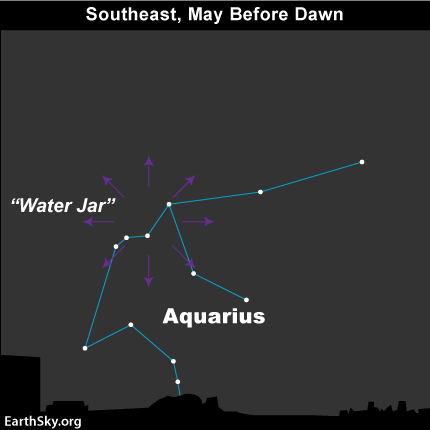
The famous Eta Aquariid meteor shower – one of the year’s major meteor showers – peaks every year in early May. In 2019, the peak centers around May 5. This shower is known to be richer as seen from Earth’s Southern Hemisphere than from the Northern Hemisphere. Why?
If you traced the paths of Eta Aquarid meteors backward on the sky’s dome, you’d find that these meteors appear to stream from an asterism, or recognizable pattern of stars, known as the Water Jar in the constellation Aquarius.
This spot in the sky is the radiant point of the Eta Aquarid meteor shower. The meteors seem to emanate from the vicinity of the Water Jar, before spreading out and appearing in all parts of the sky.

The radiant point of the Eta Aquarid meteor shower is near the famous Water Jar asterism of the constellation Aquarius.
Because the Water Jar is on the celestial equator – an imaginary great circle directly above the Earth’s equator – the radiant of the Eta Aquarid shower rises due east as seen from all over the world. Moreover, the radiant rises at about the same time worldwide, around 1:40 a.m. local time (2:40 a.m. Daylight Saving Time) in early May, around the shower’s typical peak date.
So you’d think the shower would be about the same as seen from around the globe.
But it’s not. The reason it’s not is that sunrise comes later to the Southern Hemisphere (where it’s autumn in May) and earlier to the Northern Hemisphere (where it’s spring in May).
Later sunrise means more dark time to watch meteors. And it also means the radiant point of the Eta Aquarid shower has a chance to climb higher into the predawn sky as seen from more southerly latitudes. That’s why the tropics and southern temperate latitudes tend to see more Eta Aquarid meteors than we do at mid-northern latitudes.
Cruise to a southerly latitude, anyone?
Everything you need to know: Eta Aquarid meteor shower
Bottom line: Everyone around the globe can enjoy the Eta Aquariid meteor shower in early May. Best for the Southern Hemisphere! Peak in 2019 is on or near the morning of May 5.
Read more: EarthSky’s annual meteor shower guide
Source:
https://earthsky.org/space/why-more-eta-aquarid-meteors-in-southern-hemisphere

